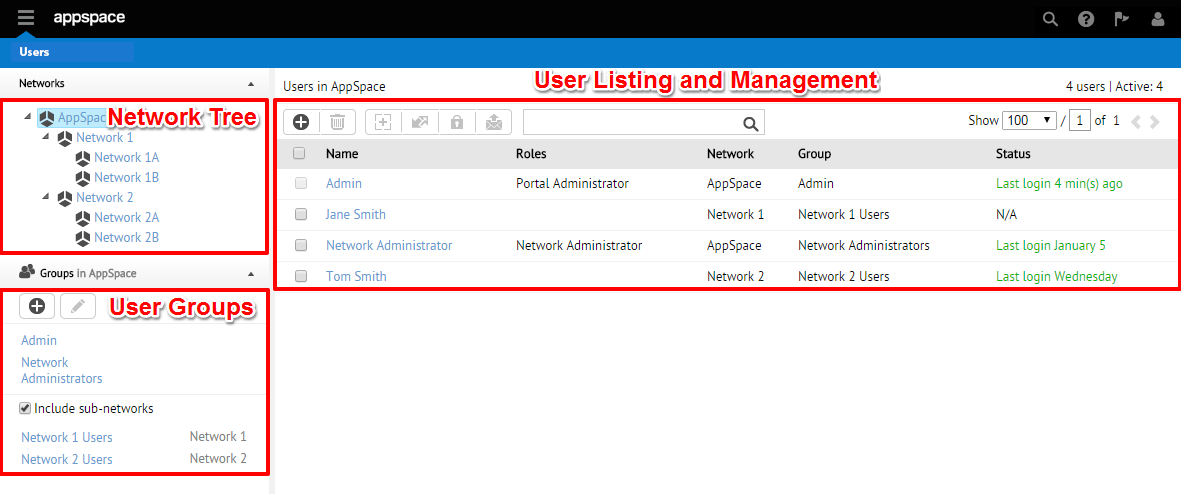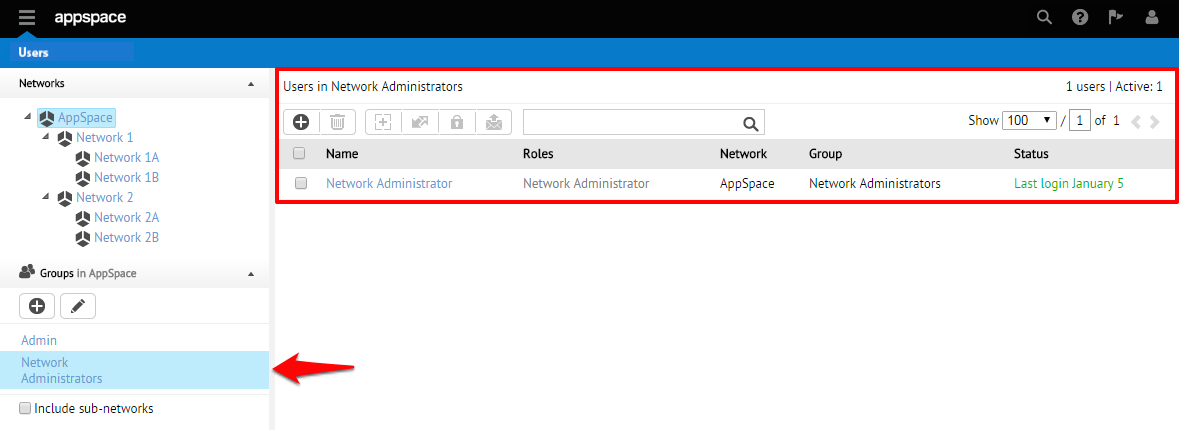Introduction to Users
The Users extension allows Appspace administrators to manage users and user groups. A user can be assigned different predefined user roles, such as Portal Administrator, Account Administrator, Content Administrator, and such, which will determine their access levels to the different features and extensions in Appspace. A user can also be assigned to a custom created user group in a custom created network. This provides Appspace administrators with an overview of all users on the server, identify the groups they belong to, and the roles assigned to them.
User Role Definitions
Account Owner
The Account Owner has access to everything within the account with the exception of configuring system settings. As an Account Owner, you are able to manage all users, user groups, networks, devices, content assets, applications and manage all add-on extensions within your account.
Network Administrator
Users that are granted the Network Administrator role will have visibility to all network properties and sub-networks within their network. This role allows them to define (add/delete/edit) the structure of their network, create and manage users (and user groups) within the network, and register and manage player devices and player groups.
Content Administrator
The Content Administrator will typically be the head of the app design team or marketing team and will have an overview to all apps and content within their current network. A Content Administrator will be able to access any app, widget or content that exists within the network. If a content widget requires approval in order for content to be updated, they will also have the ability to approve or reject content updates to widgets. In a typical workflow, a content manager can upload or allocate a new piece of content to a widget, but the update will only happen if it is approved by a Content Administrator.
Content Producer
Content Producers will be able to access the Library to upload and manage content items within the account. As a content producer, you’ll be able to populate and manage all content assets within the Library. This role can be assigned to users from third-party content producing companies to grant them access to the Library while restricting access to all other extensions and settings.
User
Users that are new to Appspace will be initially registered as a standard user. A standard user will only have access to the dashboard.
Role Management
There are several predefined system roles with different access levels in Appspace, created for the standard Appspace workflow, which are as follows:
- Portal Administrator: this role is reserved for the system administrator and has access to all settings, accounts, and networks in the Appspace server.
- Accounts Administrator: this role is scoped to all accounts under the administration of the user. The user has access to everything within all accounts that they manage.
- Network Administrator: this role is scoped to the current network the user belongs to. The user will be able to access all applications and content under that network.
- Content Administrator: this role is scoped to all the apps that reside within the current user’s network. The user will be able to access the properties of an app, and content for all apps including the associated content in the Appspace Library.
- Content Manager: this role is scoped to the content within an app to which the user has entitlement rights. The user will be able to access all content elements inside that app.
- Schedule Manager: this role is scoped to the scheduling of layouts and content within an app to which the user has entitlement rights. The user will be able to manage the scheduling of these elements inside the app.
- Widget Manager: this role is scoped to the management of widgets within an app to which the user has entitlement rights. The user will be able to access all widgets inside that app.
- User: this is a generic user role that provides visibility to any content that is created by the user. The user will only be able to access apps and content created by him/her.
Extension Access Matrix
When a user is granted visibility to an extension, it’s automatically implied that the user will also be given full access to everything within that extension, with the only exception of application permissions.
| Access to | Portal Administrator | Account Owner | Network Administrator | Content Administrator | Content Producer | User |
|---|---|---|---|---|---|---|
| User Profile | ✔ | ✔ | ✔ | ✔ | ✔ | ✔ |
| Account Settings | ✔ | ✔ | ✘ | ✘ | ✘ | ✘ |
| System Settings | ✔ | ✘ | ✘ | ✘ | ✘ | ✘ |
| Device Tasks | ✔ | ✔ | ✔ | ✘ | ✘ | ✘ |
| Campaigns | ✔ | ✔ | ✔ | ✔ | ✘ | ✘ |
| Library | ✔ | ✔ | ✔ | ✔ | ✔ | ✘ |
| Dashboard | ✔ | ✔ | ✔ | ✔ | ✔ | ✔ |
| Languages | ✔ | ✘ | ✘ | ✘ | ✘ | ✘ |
| Rooms | ✔ | ✔ | ✔ | ✔ | ✘ | ✘ |
| Networks | ✔ | ✔ | ✔ | ✘ | ✘ | ✘ |
| Alerts | ✔ | ✔ | ✘ | ✘ | ✘ | ✘ |
| Reports | ✔ | ✔ | ✔ | ✔ | ✘ | ✘ |
| Signs | ✔ | ✔ | ✔ | ✔ | ✘ | ✘ |
| Users | ✔ | ✔ | ✔ | ✘ | ✘ | ✘ |
| Play | ✔ | ✔ | ✔ | ✔ | ✘ | ✘ |
Users Layout and Interface
The following illustrates the layout of the Users extension in Appspace.

Network Tree
The collapsible network tree in the Users extension is replicated from the Appspace server’s current network topology created through the Networks extension. When a network or or subnetwork is selected, the interface will dynamically change to display the users and user groups assigned to that network.

User Groups
The Groups section lists the user groups that currently exist in the selected parent network or subnetwork, where you can add or edit user groups. When a user group is selected, the interface will dynamically change to display only the users within that group.
There is also an option to display user groups that exist in subnetworks. This ‘Include sub-networks’ option is disabled by default.

User Listing
This section lists all user accounts that fall within the user groups of the currently selected network or sub-networks. This dashboard also serves as the main interface for various user management workflows such as inviting new users, deleting existing users, assigning roles, moving users across groups, and suspending user accounts. The user listing table also provides useful at-a-glance information regarding each user’s current roles, network location, user group that they belong to, and last known server login activity. A search bar is also included as a tool for the quick search of specific user names or accounts.
